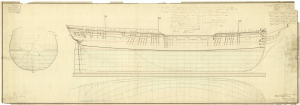 Plan used for the Diana Plan used for the Diana
| |
| History | |
|---|---|
| Name | HMS Diana |
| Ordered | 28 March 1793 |
| Builder | Randall & Brent, Rotherhithe |
| Laid down | March 1793 |
| Launched | 3 March 1794 |
| Completed | 6 June 1794 |
| Out of service | Sold to the Dutch Navy on 7 March 1815 |
| Honours and awards | Naval General Service Medal with clasp "Egypt" |
| Name | Diana |
| Acquired | Bought from the British on 7 March 1815 |
| Fate | Destroyed in dry-dock accident on 16 January 1839 |
| General characteristics | |
| Type | 38-gun Artois-class fifth-rate frigate |
| Tons burthen | 999 3⁄94 bm |
| Length |
|
| Beam | 39 ft 3+1⁄2 in (12.0 m) |
| Depth of hold | 13 ft 9 in (4.19 m) |
| Sail plan | Full-rigged ship |
| Complement | 270 (later 315) |
| Armament |
|
HMS Diana was a 38-gun Artois-class fifth-rate frigate of the Royal Navy. She was launched in 1794.
Sometime in late January or February, 1800 she recaptured the American schooner Sally and Mary that had been captured by a French privateer. The schooner was sent in to St. Kitts. Because Diana served in the Royal Navy's Egyptian campaign between 8 March 1801 and 2 September, her officers and crew qualified for the clasp "Egypt" to the Naval General Service Medal that the Admiralty authorized in 1850 to all surviving claimants.
She was at Tangiers 19 January, 1804.
Diana participated in an attack on a French frigate squadron anchored at Saint-Vaast-la-Hougue at the action of 15 November 1810, which ultimately led to the destruction of the French frigate Elisa. (Boats from Diana went in and set fire to the beached Eliza despite heavy fire from shore batteries and three nearby armed brigs; the British suffered no casualties.)
In January or February 1812, the French captured Patent, Gillespie, master. Diana recaptured Patent on 4 February. Patent arrived at Plymouth on 6 February.

Fate
On 7 March 1815, Diana was sold to the Dutch Navy for £36,796. On 27 August 1816, she was one of five Dutch frigates and one corvette that participated in the bombardment of Algiers. Her captain then was Pieter Ziervogel. The ship suffered 6 dead and 22 wounded in the action.
HNLMS Diana was destroyed in a fire on 16 January 1839 while in dry-dock at Willemsoord, Den Helder.
Notes
- A first-class share of the prize money awarded in April 1823 was worth £34 2s 4d; a fifth-class share, that of a seaman, was worth 3s 11½d. The amount was small as the total had to be shared between 79 vessels and the entire army contingent.
Citations
- "No. 21077". The London Gazette. 15 March 1850. pp. 791–792.
- "Naval Documents related to the Quasi-War Between the United States and France Volume Part 1 of 4 Naval Operations January to May, 1800, Front Matter January Pg. 133" (PDF). U.S. Government printing office via Imbiblio. Retrieved 7 June 2024.
- "No. 17915". The London Gazette. 3 April 1823. p. 633.
- Naval Documents related to the United States Wars with the Barbary Powers Volume III Part 2 of 3 September 1803 through March 1804 (PDF). U.S. Government Printing Office. p. 349. Retrieved 16 December 2024 – via Ibiblio.
- "No. 16438". The London Gazette. 25 December 1810. p. 2061.
- "No. 16598". The London Gazette. 28 April 1812. p. 813.
- "The Marine List". Lloyd's List. No. 4638. 11 February 1812. hdl:2027/uc1.c2735025. Retrieved 7 October 2020.
References
- Colledge, J. J.; Warlow, Ben (2006) . Ships of the Royal Navy: The Complete Record of all Fighting Ships of the Royal Navy (Rev. ed.). London: Chatham Publishing. ISBN 978-1-86176-281-8.
- Winfield, Rif (2007). British Warships in the Age of Sail 1794–1817: Design, Construction, Careers and Fates. Seaforth. ISBN 978-1-86176-246-7.
- HMS Diana at Modelships.de – ship model with a short description.
- HMS Diana at Jotika Ltd. – another model with additional info.
| Artois-class frigates | |
|---|---|
| |
| Shipwrecks and maritime incidents in 1839 | |
|---|---|
| Shipwrecks |
|
| Other incidents |
|
| 1838 | |
This article about a specific military ship or boat of the Netherlands is a stub. You can help Misplaced Pages by expanding it. |
This article about a specific naval ship or boat of the United Kingdom is a stub. You can help Misplaced Pages by expanding it. |